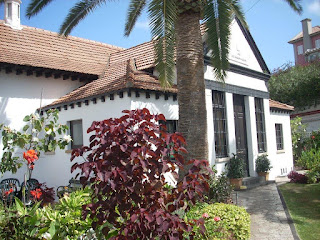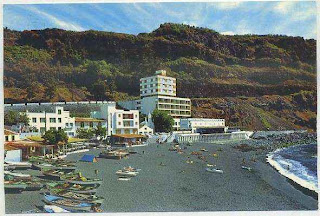In 1620, a group of Puritans, better known as the Pilgrim
Fathers, sailed across the Atlantic Ocean from the English port of Plymouth on
a square-rigged brigantine called Mayflower.
There were other Mayflowers. One of them sailed to Tenerife in 1776, the same year Captain James Cook made use of the anchorage bay of Santa Cruz to take on supplies for his last voyage of discovery. This Mayflower weighed 150 tons and carried fourteen guns, for self-defence, like any merchant vessel of the time.
Her master was Pleford Clark, an experienced seaman. As all sailors did, he knew very well that every voyage may be his last. There were enemies around every head of land. Merchantmen like the Mayflower were at the mercy of marauding pirates and privateers. The Spaniards, the English, the French and the Dutch all raided each others' boats on the Atlantic trading routes. Even Turkish and Algerian sailors ventured out into the Atlantic and would carry our mischievous and ruthless forays against fat European vessels.
Sailing to the Canary Islands, even in the early 19th century, was risky and dangerous. It was also tough, with ships very often running out of food and water. A modern cruise liner will be nudged gently against the south mole in Santa Cruz de Tenerife after leaving Southampton in just four or five days. Eighteenth century vessels like the Mayflower could take weeks to complete the voyage. Their square rigging meant they depended on the convenient direction and strength of the winds to make any headway. They often ran into rocks or uncharted sandbanks and sometimes had to seek shelter for days on end in friendly coves until a privateer or an enemy vessel became tired of waiting and moved on.
On her maiden voyage, the Mayflower sailed down the Thames and into the
English Channel in the company of three or four other ships, all laden with
wheat and every single one of them bound for the island of Tenerife. Pleford Clark had an uneasy time
with changing winds before finally beating it out of the English Channel and
heading south, pushed by the trade winds. By then, all ships in that particular trading fleet had lost
sight of each other.
On her way south the Mayflower passed Porto Santo of the Madeiras on her starboard beam and then, two days later, the Savage Islands, half-way between Madeira and the Canaries. The Savage Islands are located at 170 km north of the Anaga cliffs, in Tenerife, and almost 290 km south-southeast of São Lourenço, in Madeira.
These Savage islands, Selvagem in Portuguese, comprise three small islands, Selvagem Grande, Selvagem Pequena and Ilhéu de Fora. These rocky, weather-beaten landscapes have belonged to Portugal since 1438, in spite of Spanish protests over the years. In fact, a little over twenty years ago, Spain claimed the tiny islands should be classified as rocks, effectively eliminating Portuguese sovereign rights over them as islands. This tit-for-tat reaction at the time was a result of the Portuguese preventing Canary Island fishing vessels from fishing within coastal waters.
Much earlier, in 1971, the islands became the Savage Islands Nature Reserve for their importance
in the nidification of certain bird species, especially Cory's Shearwater.
Pleford Clarks's voyage was a safe and speedy one. They were anchored off Port Orotava, what today we know as Puerto de la Cruz, only twenty days after leaving the English Channel. Several other merchant ships lay at anchor. The Mayflower would have to wait its turn. All the ships were loading up barricas or casks of Tenerife’s famous wines which were destined for the inns of England and Europe or for the colonies on the other side of the Atlantic.
It was towards the end of October and Mount Teide was completely white after a recent snowfall. The little taverns were jolly with foreign sailors gulping cups of Malmsey wine and eating what the host offered as the dish of the day. Some historians believe these food-providing taverns were in fact origins of the inns Canary Islanders refer to as guachinche and that the word derives from an old English or Irish expression “I’m watching ye”. Perhaps they feared the wines would be watered down for the benefit of the innocent foreigner!
When it was the Mayflower’s turn, Pleford Clark began to unload his supply of wheat before cramming up with barrels of wine. It was a slow process. Everything had to be ferried in and out by falua, long narrow boats also used for fishing. There were no safe coves along the north coast of Tenerife. There were no proper trading ports yet since the original Garachico gateway to land was buried during the volcanic eruption of 1706. Sailors were firmly at the mercy of the seas.
In fact, by late October the Atlantic had begun to show its
temper. Pleford Clark was forced to weigh anchor and make for the open
sea. Safely away from the treacherous volcanic coastline, he would sail back and forth and await patiently for the waters to settle down again. It was
a common occurrence and the Mayflower was forced to repeate the operation at least five times off
Port Orotava before completing her load of wine for the inns of London.
Wine was a profitable business and Tenerife’s vineyards, as William Shakespeare recorded in works like The Merry Wives of Windsor, produced the finest wines, just as they do today. The Mayflower could not return to England without her full capacity. On this, her maiden voyage, it took six weeks to unload her grain and to load up her 360 casks of wine purchased at Port Orotava. Fully loaded, Pleford Clark then sailed his ship along the northwest coast as far as Garachico. Garachico was also where ships preferred to take on supplies of water because it was considered the purest.
The return voyage to England was not a dull one although, due to unfavourable winds, the crew aboard the Mayflower could still see Garachico five days after weighing anchor.
Close to Madeira, the Mayflower’s lookout spotted what he considered to be an unfriendly sail. She was moving to intercept them from the west. She was indeed what was known as a Sallee Rover. These bloodthirsty mariners, often actually led by English or Dutch captains who had made the walled, medieval merchant port of Salé in Morocco their base, were Barbary pirates.
Sailors dreaded encountering theses small pirate ships. They could easily outmanoeuvre the larger European merchantmen and the crews manning these small vessels had a very bloody reputation, attacking at all cost for the smallest of prizes.
There was no point seeking shelter in one of the Madeira Islands because the Moroccan would simply follow the Mayflower. Pleford Clark knew he had to make a run for it. Although the other could manoeuvre with ease, the Mayflower had a strong wind behind her whereas the pirate, heading eastwards from its hiding place in a Madeiran cove, appeared to be making heavy weather of it.
Indeed the Mayflower slipped past and northwards at a good rate. The Moroccan gave up the chase and continued in a south-easterly direction, possibly back to Salé. Their best weapon was the surprise approach and on this occasion they had been spotted in time. From there on the voyage home was uneventful. Nevertheless Pleford Clark did have the strange pleasure of exchanging greetings with what was known as a friendly pirate, in this case a roaming Dutchman marauding in waters between the English Channel and the Bay of Biscay. He was only interested in terrorising fat French merchants returning to Le Havre or Bordeaux.
The Mayflower made several journeys over the years to pick up good wines from Port Orotava, and even from the Bodegas beach in Taganana. She was only one example of the many foreign vessels which began to trade with these islands very soon after the Spanish conquest concluded in 1496.
There were
many more, especially ships of the British East India Company, which simply used
the Canary Islands to stock up with food and water before heading south down
the coast of Africa on their way to towards the Indian Ocean. Above
is Thomas Luny's detailed painting showing the company’s Hindustan anchored off the
rocky coast of Tenerife. A small local craft moves swiftly by in the foreground and the peak of Mt Teide far beyond peeps into the clouds.
Note: Some information was adapted from Barlow's Journal, a sailor's account of
his Life at Sea in King's Ships, East and West Indiamen and Other Merchantmen.
Certain images have been reproduced from internet with no personal financial
gain intended.
By John Reid Young, author and Canary Island private tour
#guide.
Books by John include:
The Skipping Verger and Other Tales, a selection of
historical, very short #stories.
A Shark in the Bath and Other Stories, a selection of
longer, semi-biographical short stories.
El Hombre
de La Guancha y Otras Historias, a selection of short stories in
Spanish.
The Journalist, a novel described as a political thriller.
For more information, or if you would like to read any of
my books, please click on the images to the right of the web version of this
page.
You can also sign up for an occasional newsletter on these links:
Facebook: https://www.facebook.com/theskippingverger
X: @reidten
Instagram: authorjohnreidyoung













.jpg)
.jpg)


.jpg)




.jpg)
.jpg)











